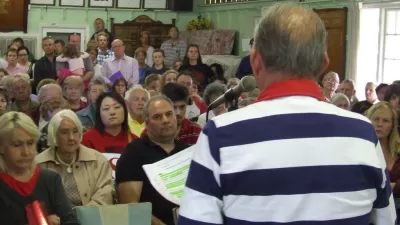What does it mean to truly involve the public in planning processes? Neeraj Mehta finds "too much placation, manipulation and tokenism in our engagement efforts," and identifies principles for collective problem-solving and shared decision-making.
The public is an incredible, and essential, asset in the successful creation, implementation, and utilization of the products of planning and development. However, Mehta finds that too often, planners neglect the value of this asset to the planning process by "wanting people to participate
without giving them the opportunity to make real decisions."
"Much of the challenge, as I see it, is based in reflection of what we
actually believe about the public and about the role and value of
engagement more broadly," says Mehta. "There is a distinct difference between
assessing people's opinions or attitudes and actually sharing planning
and decision-making responsibilities. There's a difference between real
partnerships and simply asking people to rubber-stamp decisions we've
already made...We devalue
investments in time and relationship building, which often leads to us
more easily devalue the contributions and expertise of those we engage."
She offers three fundamental principles that can guide the development of truly meaningdul community engagement strategies:
- Acknowledge our interdependence and need for increased diversity.
- Be honest with the complexity.
- Be comfortable with uncertainty and controversy.
FULL STORY: The First Steps to Meaningful Community Engagement

Study: Maui’s Plan to Convert Vacation Rentals to Long-Term Housing Could Cause Nearly $1 Billion Economic Loss
The plan would reduce visitor accommodation by 25,% resulting in 1,900 jobs lost.

North Texas Transit Leaders Tout Benefits of TOD for Growing Region
At a summit focused on transit-oriented development, policymakers discussed how North Texas’ expanded light rail system can serve as a tool for economic growth.

Why Should We Subsidize Public Transportation?
Many public transit agencies face financial stress due to rising costs, declining fare revenue, and declining subsidies. Transit advocates must provide a strong business case for increasing public transit funding.

How to Make US Trains Faster
Changes to boarding platforms and a switch to electric trains could improve U.S. passenger rail service without the added cost of high-speed rail.

Columbia’s Revitalized ‘Loop’ Is a Hub for Local Entrepreneurs
A focus on small businesses is helping a commercial corridor in Columbia, Missouri thrive.

Invasive Insect Threatens Minnesota’s Ash Forests
The Emerald Ash Borer is a rapidly spreading invasive pest threatening Minnesota’s ash trees, and homeowners are encouraged to plant diverse replacement species, avoid moving ash firewood, and monitor for signs of infestation.
Urban Design for Planners 1: Software Tools
This six-course series explores essential urban design concepts using open source software and equips planners with the tools they need to participate fully in the urban design process.
Planning for Universal Design
Learn the tools for implementing Universal Design in planning regulations.
City of Santa Clarita
Ascent Environmental
Institute for Housing and Urban Development Studies (IHS)
City of Grandview
Harvard GSD Executive Education
Toledo-Lucas County Plan Commissions
Salt Lake City
NYU Wagner Graduate School of Public Service





























